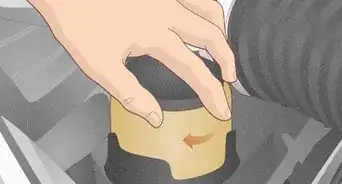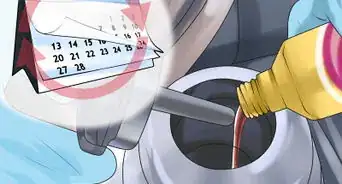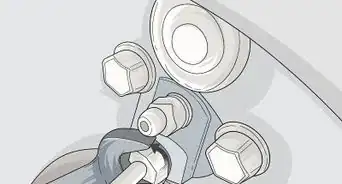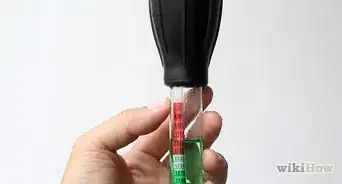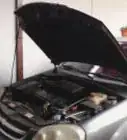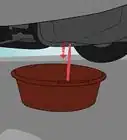This article was co-authored by Tom Eisenberg. Tom Eisenberg is the Owner and General Manager of West Coast Tires & Service in Los Angeles, California, a family-owned AAA-approved and certified auto shop. Tom has over 10 years of experience in the auto industry. Modern Tire Dealer Magazine voted his shop one of the Best 10 Operations in the Country.
There are 14 references cited in this article, which can be found at the bottom of the page.
This article has been viewed 129,203 times.
Starting fluid is a liquid that helps internal combustion engines operate properly. Starting fluid is often used to start cars the engines of which have been poorly maintained, or for starting older cars when the temperature falls below freezing.
Steps
Quick Preparations Before You Start
-
1Store starting fluid safely. Starting fluid is highly flammable and combustible. Store and handle them safely. For instance, do not place your can of starting fluid on a hot engine or spray it near a hot engine.[1]
-
2Do not use excessive amounts of starting fluid. Too much starting fluid can damage your engine. Consult your vehicle user’s manual and the user directions appended to the starting fluid in order to determine the appropriate volume of starting fluid for your vehicle.[2]
- Typically, a couple of short bursts of starting fluid should be adequate to get your engine started.
Advertisement -
3Check to make sure you can use starting fluid with your vehicle. Starting fluid cannot be used with all vehicles. For instance, if your vehicle is equipped with glow plugs, or if your vehicle uses diesel fuel, you will not be able to utilize starting fluid.[3] Check your vehicle’s user guide to ensure starting fluid is appropriate for use with your vehicle.[4]
-
4Choose a quality starting fluid. Only use trusted brands when selecting a starting fluid. A good starting fluid should start the engine quickly with a minimal application volume. Ask your local auto shop what sort of starting fluid they recommend for your vehicle.[7]
Applying the Fluid
-
1Locate your air intake. Air intakes are devices on all vehicles that allow the engine to mix air with fuel, thus making combustion possible. While the air intake will always be attached to the engine housed beneath the hood, different manufacturers produce their vehicles to different specifications, and so air intakes are located in different locations on different vehicles. Consult your vehicle’s user guide to identify the location of your air intake.[8]
- Air intakes often look like metal tubes. They might be powder-coated or painted in the same color as the vehicle.
-
2Spray a small amount of starting fluid into the air intake. Keep the can of starting fluid upright. Aim the can’s nozzle at the air intake from about 12 inches (20 centimeters) away. Spray the starting fluid for about two seconds, then try to turn the engine over. If the engine still doesn’t turn over, spray another two-second blast.[9]
- You many need to remove the filter covering your air intake to do this.[10]
-
3Take your vehicle to a mechanic if it doesn’t start. If the engine won’t start even with an appropriate application of starting fluid, the engine itself might not be the problem. For instance, your car’s ignition switch might be faulty, or some other system could be to blame. Talk to a reputable mechanic in your area and get their opinion on how to handle the problem.[11]
Troubleshooting a Car That Won’t Start
-
1Adjust the choke. If your vehicle has a carburetor (a device that mixes air and fuel) and it will not start, check the choke. If your choke is closed when you try to turn the vehicle over, open it. If it was open when you try to turn the vehicle over, close it.[12]
- Adjusting the choke is also a good idea when your car has a carburetor and starts, but then turns off.
- If you cannot locate your choke, consult your vehicle’s user manual.
-
2Check for moisture. If your car has a hard time starting on rainy days, look inside the distributor cap. If you see moisture inside the distributor cap, turn the cap upside down and spray it with mechanic’s solvent (or, if you have a bottle of solvent rather than a spray can, pour some of the solvent into the cap). Swish the solvent around, then pour it out. Use a clean rag to wipe out any additional solvent before replacing the cap.[13]
- The distributor cap is a small cover that protects your car’s distributor.
-
3Check your battery. If you don’t even hear a sputter when you turn the ignition, the terminal cables to the battery are probably not connected properly. If the terminal connections look corroded, jam a screwdriver between the connector and the terminal post. Twist the screwdriver to tighten the connection. Try the engine. If it starts, clean or replace the battery cables.[14]
- When adjusting the connector and terminal post, use a screwdriver with an insulated or wooden handle.
Expert Q&A
Did you know you can get expert answers for this article?
Unlock expert answers by supporting wikiHow
-
QuestionMy car won't start even after I sprayed starting fluid. What can I do?
 Tom EisenbergTom Eisenberg is the Owner and General Manager of West Coast Tires & Service in Los Angeles, California, a family-owned AAA-approved and certified auto shop. Tom has over 10 years of experience in the auto industry. Modern Tire Dealer Magazine voted his shop one of the Best 10 Operations in the Country.
Tom EisenbergTom Eisenberg is the Owner and General Manager of West Coast Tires & Service in Los Angeles, California, a family-owned AAA-approved and certified auto shop. Tom has over 10 years of experience in the auto industry. Modern Tire Dealer Magazine voted his shop one of the Best 10 Operations in the Country.
Auto Technician
References
- ↑ https://books.google.com/books?id=3MAXAAAAYAAJ&pg=PA34#v=onepage&q&f=false
- ↑ https://books.google.com/books?id=3MAXAAAAYAAJ&pg=PA34#v=onepage&q&f=false
- ↑ http://www.military.com/off-duty/autos/getting-diesel-engines-started-on-a-frosty-morning.html
- ↑ https://www.reference.com/vehicles/start-engines-starting-fluid-9c12d19306f6eead
- ↑ http://www.wisegeek.com/what-is-starter-fluid.htm#didyouknowout
- ↑ http://www.popularmechanics.com/cars/how-to/a2883/4296198/
- ↑ http://www.oreillyauto.com/site/c/search/Starting+Fluid/N0402/C0126.oap
- ↑ http://www.sgcarmart.com/news/writeup.php?AID=127
- ↑ https://books.google.com/books?id=mDsCQGf0MC8C&lpg=PA66&pg=PA66#v=onepage&q&f=false
- ↑ https://www.farmandfleet.com/blog/what-is-starting-fluid/
- ↑ https://www.reference.com/vehicles/start-engines-starting-fluid-9c12d19306f6eead
- ↑ http://www.dummies.com/home-garden/car-repair/troubleshooting-a-car-that-wont-start/
- ↑ http://www.dummies.com/home-garden/car-repair/troubleshooting-a-car-that-wont-start/
- ↑ http://www.dummies.com/home-garden/car-repair/troubleshooting-a-car-that-wont-start/
About This Article
Starting fluid is a liquid that can help your engine work properly. To use starting fluid on your car, you’ll need to check if it’s appropriate for your vehicle and apply it to the air intake. Remember to never spray it on a hot engine, since it’s highly flammable. Check your user manual to see if starting fluid can be used on your car, since you can’t use it on diesels and some other models. If you can’t use it on your vehicle, try a carburetor cleaner. If you can use it, spray a short burst of the fluid into your engine’s air intake. This typically looks like a metal pipe and is usually found somewhere around the engine. Afterwards, try starting your car. If your engine fails to start after you’ve applied starting fluid, take your vehicle to a mechanic to examine the problem. For tips from our Auto co-author on how to identify a good brand of starter fluid, keep reading!












